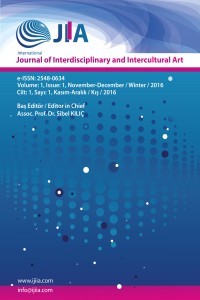19.Yüzyılda Gizemli Bir İkona Ressamı: Mikhail Vrubel
Modern sanat akımları için 19.yüzyılın sonu en ilginç dönemlerden biridir. Yüzyıl sonu olarak adlandırılan bir ruh durumu içinde yaşayan ve üreten sanatçıların, sanatta biçim ve öz hakkındaki araştırmalarını derinleştirmeleri, birbirinden görece farklı fakat temelde aynı motivasyonda birçok akımın doğmasına sebep olmuştur. Özellikle öznel bir bakış açısının yükselerek evrenle bir bütün olma düşüncesinin benimsendiği yeni bir felsefeyle açılan kapılar, sanata ilginç ve farklı konular sokmakla kalmıyor, bu konuları biçimlendirecek seçici araçlar da sağlıyordu. Rus sanatçı Mikhail Vrubel’in vizyonu da erken yaştan itibaren bu şekilde gelişerek çevresel etmenler, geçmiş sanatlar ve içinde bulunduğu kültür dairesinden edindikleri, kişisel ruh durumu ve yapısı ve yer aldığı projelerde edindiği tecrübelerle zenginleşerek onu Rus Modernizminin en önemli figürlerinden biri haline getirmiştir. Eğitimini gördüğü sırada edindiği akademik üslubun yanında çalışma alanlarında pratiğini yapmak adına incelediği İtalo-Bizans mozaiklerinin etkileri, onun sanatının yapısının altyapısını oluşturmada ortak bir rol oynamıştır. Zaman içerisinde Hıristiyanlık sanatı haricinde eski Rus kültürünün halkbilim ve mitoloji motifleriyle ve 19.yüzyıl Rus edebiyatının etkileriyle de süslenerek zenginleşen yeni bir konu içeriği, Vrubel’in sanatına dahil olarak konu içeriğini zenginleştirerek, konu açısından da onu salt ikona ressamı olma çizgisinden çıkarmıştır. Sanatçının kırılgan iç dünyasının zenginliğinin yansıdığı çalışmalar, halkbilim, dini motifler ve mitolojiyle harmanlanan karakterlerle donatılmış bir dünyaya ait elemanlar haline gelmekteydi. Ayrıca sanatının biçimsel yönündeki süregelen arayış ve değişim ile çağdaşlarından belirgin şekilde ayrılma, onun ülkesinin sonraki sanatçı kuşakları tarafından da benimsemesini sağlamıştı. Bu durum, konu hakkında yazan birçok Rus sanatçının O’nu, gerçekçi bir gelenekten gelen Rus sanatındaki dışavurumculuğun ve ayrıca biçimde araştıran zihinsel yapısı ile soyutlamanın temelini atan kişilerden biri olduğu yönündeki ifadeleriyle güçlenmektedir. Bu araştırmada Mikhail Vrubel’in sanatının oluşumu, gelişimini oluşturan etmenler tüm yönleriyle ele alınmış, dönem ve akım özellikleri incelenmiştir. Ayrıca sanatçının sanatına ait unsurlar, eserleri ile örneklendirilerek açıklanmış, sanatçı ve akım ile ilişkilendirilmiştir.
A MYSTERIOUS ICON PAINTER IN THE 19TH CENTURYs. MIKHAIL VRUBEL
The end of the 19th century is one of the most interesting periods for modern art movements. The deepening of researches on form and essence in art by artists living and producing in a mood called the end of the century has led to the emergence of many movements that are relatively different from each other but basically have the same motivation. The doors opened with a new philosophy, in which the idea of becoming one with the universe by rising a subjective point of view was adopted, not only introduced interesting and different subjects to art, but also provided selective tools to shape these subjects. The vision of Russian artist Mikhail Vrubel developed in this way from an early age, enriched by the environmental factors, past arts and the cultural circle he was in, his personal mood and structure, and the experiences he gained in the projects he took part in, making him one of the most important figures of Russian Modernism. In addition to the academic style he acquired during his education, the effects of the Italo-Byzantine mosaics, which he studied in order to practice in his work areas, played a common role in forming the infrastructure of the structure of his art. In time, a new subject content enriched by being embellished with folklore and mythology motifs of old Russian culture and the effects of 19th century Russian literature, apart from Christian art, enriched the subject content by being included in Vrubel's art, and removed him from the line of being a mere icon painter in terms of subject matter. The works, which reflected the richness of the artist's fragile inner world, became elements of a world equipped with characters blended with folklore, religious motifs and mythology. In addition, the ongoing search and change in the stylistic aspect of his art and the apparent separation from his contemporaries enabled him to be embraced by the next generations of artists in his country. This situation is strengthened by the statements of many Russian artists writing on the subject that he is one of the people who laid the foundation for expressionism in Russian art, which comes from a realist tradition, and also for abstraction with his mental structure that explores form. In this research, the formation of Mikhail Vrubel's art and the factors that make up its development are discussed in all aspects, and the period and movement characteristics are examined. In addition, the elements of the artist's art are explained by exemplary with his works and associated with the artist and the movement.
___
- Akkaya, T. (2000). Ortodoks İkonaları, İstanbul: Arkeoloji ve Sanat Yayınları.
- Barberis-Grasser, M-A. (1993). “Romantizm. Milli Bilinci Canlandıran Akım”. Thema Larousse. İstanbul: 5. cilt, 86-87.
- Byrns, R. H. (1979). The Artistic Worlds of Vrubel ’and Blok. The Slavic and East European Journal, 23(1), 38–50. https://doi.org/10.2307/307798
- Finger, J. (1917). Décadence in Russian Art. Arts & Decoration (1910-1918), 7(5), 241–272. http://www.jstor.org/stable/43808975
- Gerould, D. (2009). The Symbolist Legacy. PAJ: A Journal of Performance and Art, 31(1), 80–90. http://www.jstor.org/stable/30131091
- Little, S. (2006). İzmler-Sanatı Anlamak. (Çev: D. N. Özer). İstanbul: Yapı Yayın. s.66-67.
- Öndin, N. (2019). Modern Sanat. İstanbul: Hayalperest.
- Reeder, R. (1976). Mikhail Vrubel’: A Russian Interpretation of “fin de siècle” Art. The Slavonic and East European Review, 54(3), 323–334. http://www.jstor.org/stable/4207296
- Şenyapılı, Ö. (2004). Romantizm. İstanbul: Boyut Yayınları, s4, 48.
- URL 1: Fin de siècle, https://www.britannica.com/art/fin-de-siecle-style, Erişim tarihi: 01,06,2022.
- URL 2: Sarabianov, Andrei D. “Mikhail Aleksandrovich Vrubel”. https://www.britannica.com/biography/Mikhail-Aleksandrovich-Vrubel, Erişim tarihi: 02.06.2022.
- URL 3: Anonim, “Mikhail Vrubel Russian Painter And Theater Designer”. https://www.theartstory.org/artist/vrubel-mikhail/ Erişim tarihi: 02,06,2022.
- Başlangıç: 2016
- Yayıncı: Sibel KILIÇ
Sayıdaki Diğer Makaleler
TÜRK GRAVÜR RESİMLERDE AQUATİNTA YÖNTEMİ İLE TONLAMA
Hava KÜÇÜKÖNER, Mustafa KÜÇÜKÖNER
AFİŞ TASARIMINDA METAFOR KULLANIMI
IGOR STRAVINSKY’NİN “SOLO KLARNET İÇİN 3 PARÇA” İSİMLİ ESERİNE YÖNELİK TEKNİK ÇALIŞMA YÖNTEMLERİ
ATIK YUMURTA KABUKLARININ 1150 OC’DE SERAMİK SIR BÜNYELERİNDE KULLANIMI
YILLAR İÇİNDE DEĞİŞEN BARBİE VE BU DEĞİŞİMİN BARBİE INSTAGRAM HESABI PAYLAŞIMLARINA YANSIMASI
Uğur GÜNAY YAVUZ, Seçil TAYLAN ERDEMLİ
KÜRESEL DÜŞÜN YEREL TASARLA: İKLİM KRİZİNE KARŞI KENT VERNAKÜLERİ YAKLAŞIMI
Dijital Sanat Çalışmalarında NFT ve Güvenilirlik
